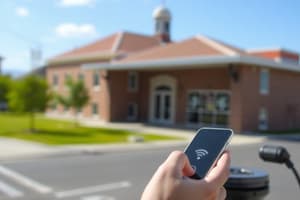Podcast
Questions and Answers
Wireless technology uses which spectrum to send data?
Wireless technology uses which spectrum to send data?
- Microwave spectrum
- Licensed radio spectrum
- Unlicensed radio spectrum (correct)
- Infrared spectrum
What is a typical limitation of older wireless access?
What is a typical limitation of older wireless access?
- Requirement to be within the transmission range of a router (correct)
- Requirement for licensed spectrum
- Unlimited range
- High cost
What is the purpose of municipal Wi-Fi networks?
What is the purpose of municipal Wi-Fi networks?
- To provide free or low-cost internet access within a city (correct)
- To control traffic lights
- To broadcast television signals
- To monitor weather conditions
What is needed to connect to a municipal Wi-Fi network?
What is needed to connect to a municipal Wi-Fi network?
What is the function of cellular service?
What is the function of cellular service?
What do 3G, 4G, and 5G refer to?
What do 3G, 4G, and 5G refer to?
What is the typical download bandwidth of 4G?
What is the typical download bandwidth of 4G?
What is the minimum download bandwidth that the 5G standard should support?
What is the minimum download bandwidth that the 5G standard should support?
What does LTE stand for?
What does LTE stand for?
In what areas is satellite internet typically used?
In what areas is satellite internet typically used?
What is needed to access satellite internet services?
What is needed to access satellite internet services?
What can affect the reception of satellite internet?
What can affect the reception of satellite internet?
What is the main purpose of WiMAX?
What is the main purpose of WiMAX?
How does WiMAX operate in comparison to Wi-Fi?
How does WiMAX operate in comparison to Wi-Fi?
What is needed to access a WiMAX network?
What is needed to access a WiMAX network?
What has largely replaced WiMAX for mobile access?
What has largely replaced WiMAX for mobile access?
What do broadband services provide to address security concerns?
What do broadband services provide to address security concerns?
What is a VPN?
What is a VPN?
Which of the following is a benefit of using a VPN?
Which of the following is a benefit of using a VPN?
How do VPNs enhance security?
How do VPNs enhance security?
Which option describes a site-to-site VPN?
Which option describes a site-to-site VPN?
What action defines remote access in VPNs?
What action defines remote access in VPNs?
What is a characteristic of single-homed ISP connectivity?
What is a characteristic of single-homed ISP connectivity?
When is single-homed ISP connectivity suitable?
When is single-homed ISP connectivity suitable?
What does dual-homed ISP connectivity provide?
What does dual-homed ISP connectivity provide?
What is a disadvantage of dual-homed ISP connectivity?
What is a disadvantage of dual-homed ISP connectivity?
What is a key feature of multihomed ISP connectivity?
What is a key feature of multihomed ISP connectivity?
What benefit does multihomed ISP connectivity offer?
What benefit does multihomed ISP connectivity offer?
What is a drawback of multihomed ISP connectivity?
What is a drawback of multihomed ISP connectivity?
Which ISP connectivity topology is the most resilient?
Which ISP connectivity topology is the most resilient?
Which ISP configuration is the most expensive?
Which ISP configuration is the most expensive?
What is a disadvantage of cable internet connections?
What is a disadvantage of cable internet connections?
What is a limitation of DSL internet?
What is a limitation of DSL internet?
With which internet option is coverage often an issue, even within a small office?
With which internet option is coverage often an issue, even within a small office?
Which internet option requires fiber installation directly to a residence?
Which internet option requires fiber installation directly to a residence?
Which internet option is typically used when there are no other available choices?
Which internet option is typically used when there are no other available choices?
What is the main purpose of using a VPN?
What is the main purpose of using a VPN?
What term describes how a VPN protects data?
What term describes how a VPN protects data?
What functionality does the Cisco Adaptive Security Appliance (ASA) provide?
What functionality does the Cisco Adaptive Security Appliance (ASA) provide?
What is Cisco AnyConnect used for?
What is Cisco AnyConnect used for?
Modern VPNs support which security encryption features?
Modern VPNs support which security encryption features?
What is a key characteristic of Site-to-Site VPNs?
What is a key characteristic of Site-to-Site VPNs?
What is a key feature of remote-access VPN?
What is a key feature of remote-access VPN?
Which broadband internet option may have slower upstream rates during peak hours due to shared bandwidth?
Which broadband internet option may have slower upstream rates during peak hours due to shared bandwidth?
What is the primary reason for using VPNs?
What is the primary reason for using VPNs?
What is the purpose of 'SSL' in clientless VPN connections?
What is the purpose of 'SSL' in clientless VPN connections?
What is the function of a VPN gateway in a site-to-site VPN?
What is the function of a VPN gateway in a site-to-site VPN?
Which type of ISP connectivity is the least expensive and provides no redundancy?
Which type of ISP connectivity is the least expensive and provides no redundancy?
Flashcards
Wireless technology
Wireless technology
Uses unlicensed radio spectrum to transmit and receive data.
Municipal Wi-Fi
Municipal Wi-Fi
Wireless networks set up by cities, offering free or low-cost internet access.
Cellular data
Cellular data
Wireless WAN technology that allows users to connect to the internet.
3G/4G/5G Wireless
3G/4G/5G Wireless
Signup and view all the flashcards
Long-Term Evolution (LTE)
Long-Term Evolution (LTE)
Signup and view all the flashcards
Satellite Internet
Satellite Internet
Signup and view all the flashcards
WiMAX
WiMAX
Signup and view all the flashcards
VPN Technology
VPN Technology
Signup and view all the flashcards
VPN
VPN
Signup and view all the flashcards
Site-to-site VPN
Site-to-site VPN
Signup and view all the flashcards
Remote Access VPN
Remote Access VPN
Signup and view all the flashcards
Single-homed ISP
Single-homed ISP
Signup and view all the flashcards
Dual-homed ISP
Dual-homed ISP
Signup and view all the flashcards
Multihomed ISP
Multihomed ISP
Signup and view all the flashcards
Dual-multihomed ISP
Dual-multihomed ISP
Signup and view all the flashcards
Fiber-to-the-Home
Fiber-to-the-Home
Signup and view all the flashcards
Cellular/Mobile
Cellular/Mobile
Signup and view all the flashcards
Satellite Internet
Satellite Internet
Signup and view all the flashcards
Virtual Private Network
Virtual Private Network
Signup and view all the flashcards
Cisco ASA Firewall
Cisco ASA Firewall
Signup and view all the flashcards
Cisco AnyConnect
Cisco AnyConnect
Signup and view all the flashcards
VPN Scalability
VPN Scalability
Signup and view all the flashcards
VPN Compatibility
VPN Compatibility
Signup and view all the flashcards
Site-to-Site VPN
Site-to-Site VPN
Signup and view all the flashcards
Remote-Access VPN
Remote-Access VPN
Signup and view all the flashcards
Remote-Access VPNs
Remote-Access VPNs
Signup and view all the flashcards
Clientless VPN connections
Clientless VPN connections
Signup and view all the flashcards
Client-based VPN connection
Client-based VPN connection
Signup and view all the flashcards
Transport Layer Security (TLS)
Transport Layer Security (TLS)
Signup and view all the flashcards
IPsec Applications
IPsec Applications
Signup and view all the flashcards
IPsec Authentication
IPsec Authentication
Signup and view all the flashcards
SSL Data integrity.
SSL Data integrity.
Signup and view all the flashcards
SSL Applications
SSL Applications
Signup and view all the flashcards
Connection Options.
Connection Options.
Signup and view all the flashcards
Site-to-site IPsec VPNS
Site-to-site IPsec VPNS
Signup and view all the flashcards
VPN Gateway Device.
VPN Gateway Device.
Signup and view all the flashcards
Cisco Adaptive Security Appliance (ASA)
Cisco Adaptive Security Appliance (ASA)
Signup and view all the flashcards
VPN Traffic
VPN Traffic
Signup and view all the flashcards
GRE over IPsec.
GRE over IPsec.
Signup and view all the flashcards
Carrier protocol
Carrier protocol
Signup and view all the flashcards
Transport protocol
Transport protocol
Signup and view all the flashcards
GRE over IPsec VPN
GRE over IPsec VPN
Signup and view all the flashcards
Passenger protocol
Passenger protocol
Signup and view all the flashcards
Study Notes
Wireless Internet-Based Broadband
- Wireless technology can send and receive data via the unlicensed radio spectrum.
- Anyone with a wireless router and technology can use this unlicensed spectrum.
- Wireless access was limited to the transmission range of a wireless router or modem, typically under 100 feet, until recently.
Municipal Wi-Fi
- Many cities are establishing municipal wireless networks.
- Municipal Wi-Fi networks offer high-speed internet access at no cost or at a significantly reduced price point.
- Some networks are for city use only, enabling remote work for police, fire departments, and city employees.
- Connecting to municipal Wi-Fi typically requires a wireless modem with a stronger radio and directional antenna than standard wireless adapters.
- Service providers offer the necessary equipment for free or for a fee, similar to DSL or cable modems.
Cellular Technology
- Cellular service is a wireless WAN technology used where other WAN access technologies are unavailable.
- Smartphones and tablets can use cellular data for typical internet activities.
- Radio waves communicate to a nearby mobile phone tower from devices using cellular technology.
- Small radio antenna is in a device, with the provider having a larger antenna on a tower within miles.
3G/4G/5G Wireless
- These are abbreviations for 3rd generation, 4th generation, and the emerging 5th generation mobile wireless technologies
- These technologies support wireless internet access.
- 4G standards support bandwidths up to 450 Mbps download and 100 Mbps upload.
- The emerging 5G standard supports 100 Mbps to 10 Gbps and beyond
Long-Term Evolution (LTE)
- Refers to a newer, faster technology
- Part of 4G technology.
Satellite Internet
- Typically used by rural users or in remote locations where cable and DSL are not available.
- Accessing satellite requires a satellite dish, two modems (uplink and downlink), and coaxial cables between the dish and modem.
- A router connects to a satellite dish pointed at a service provider satellite.
- Signals travel to and from a satellite in geosynchronous orbit, approximately 35,786 kilometers (22,236 miles).
Installation of satellite internet
- Requires a clear view toward the equator, where most orbiting satellites are located.
- Trees and heavy rains may negatively affect signal reception.
- Satellite internet offers two-way data communications for uploads and downloads.
- Upload speeds are about one-tenth of download speeds.
- Download speeds range from 5 Mbps to 25 Mbps.
WiMAX
- Worldwide Interoperability for Microwave Access (WiMAX), a new technology and is just beginning to come into use.
- It is described in IEEE standard 802.16.
- WiMAX provides high-speed broadband service with wireless access and broad coverage.
- It offers coverage similar to a cell phone network, differing from Wi-Fi hotspots.
- WiMAX operates like Wi-Fi but with higher speeds, greater range, and more users.
- It uses a network of WiMAX towers, similar to cell phone towers.
- To access WiMAX, users must subscribe to an ISP with a WiMAX tower within 30 miles of their location.
- WiMAX access requires a WiMAX receiver and a special encryption code to access the base station.
- WiMAX has largely been replaced by LTE for mobile access and cable, or DSL for fixed access.
VPN Technology
- Security risks arise when remote workers use broadband to access the corporate WAN over the internet.
- To address security, broadband services provide Virtual Private Network (VPN) connections to a network device at the corporate site.
VPN Basics
- A VPN is an encrypted connection between private networks over a public network like the internet.
- Instead of a dedicated Layer 2 connection (e.g., a leased line), a VPN uses virtual connections called VPN tunnels.
- VPN tunnels route data through the internet from the company's private network to the remote site or employee host.
- Security is a key benefit of using VPN.
Cost savings of VPN
- VPN enables organizations to use the global internet to connect remote offices and remote users to the main corporate site.
- Reduces the need for expensive, dedicated WAN links and modem banks.
Security in VPN
- VPN provides high security using advanced encryption and authentication to protect data from unauthorized access.
Scalability in VPN
- It is easy to add new users because VPNs use the internet infrastructure within ISPs and devices.
- Corporations can add large amounts of capacity without adding significant infrastructure.
Compatibility with broadband technology
- VPN technology is supported by broadband service providers like DSL and cable.
- VPNs allow telecommuters to utilize home high-speed internet services to access corporate networks.
Further Points on VPNs
- Business-grade, high-speed broadband connections offer a cost-effective solution for connecting remote offices.
- VPNs are implemented as Site-to-site VPN, and Remote Access.
Site-to-site VPN
- VPN settings are configured on routers, data is encrypted without the client's awareness.
Remote Access
- Remote Access connection requires the user to initiate the connection.
- This can be done by using HTTPS in a browser or by using VPN client software.
Single-homed ISP Connectivity
- Involves using one link for internet access
- Deployed when internet access is not critical.
- It is the least expensive of the connectivity solutions
- Provides no redundancy.
Dual-homed ISP Connectivity
- Uses two links to connect to the same ISP for internet access.
- Offers redundancy and load balancing.
- Both links can balance traffic when working properly.
- It connects to the same ISP using two links
- The organization loses connectivity if the ISP has an outage.
Multihomed ISP Connectivity
- Client connects to internet via two different ISPs.
- Offers redundancy and load balancing.
- Potentially more expensive.
Dual-multihomed ISP Connectivity
- Client connects to multiple ISPs using redundant links.
- It's the most resilient topology, providing maximum redundancy.
- Most costly option.
Broadband Solution Comparison
- Every broadband solution comes with advantages and disadvantages.
- A direct fiber-optic cable connection to the client network is an ideal solution
- Due to the limited option, some locations only offer cable or DSL, and some have broadband wireless only.
Cable
- Bandwidth is shared by users, causing upstream data rates to be slower during peak usage due to over-subscription.
DSL
- Bandwidth is limited by distance from the ISP central office.
- Upload rates are proportionally lower than download rates.
Fiber-to-the-Home
- Requires direct fiber installation to the home.
Cellular/Mobile
- Coverage issues may occur, even in small offices or home offices, where bandwidth is limited
Municipal Wi-Fi
- Few municipalities have a mesh Wi-Fi network deployed.
- A viable option for those in range if available.
Satellite
- Expensive and provides limited capacity per subscriber.
- Typically, in areas where no other option is available.
Virtual Private Network
- VPNs secure network traffic between sites and users by creating end-to-end private connections.
- A VPN carries information within a private network over a public network.
- Traffic is encrypted to keep data confidential.
VPN Use Cases
- Enterprises often use VPNs, managed from their main site, to connect remote sites and users to network resources.
- Cisco Adaptive Security Appliance (ASA) firewalls offer secure, high-performance connectivity, including VPNs.
- Cisco ASA firewalls are useful for remote branches and mobile users.
- SOHO (small office/home office) can use a VPN-enabled router to provide VPN connectivity back to the corporate main site.
Cisco AnyConnect
- It's software for remote workers to establish client-based VPN connections with the main site.
Modern VPNs
- They now support encryption features like Internet Protocol Security (IPsec) and Secure Sockets Layer (SSL) VPNs to secure network traffic between sites.
- Benefits include cost savings and security.
Costs Savings with VPN
- Organizations can reduce costs and increase remote connection bandwidth by using cost-effective, high-bandwidth technologies
Security with VPN
- VPNs employ advanced encryption and authentication to protect data, offering the highest level of available security.
Scalability
- It's easy to add new users because organizations can use the internet without significant infrastructure additions
Compatibility
- VPNs can be implemented across various WAN link options, including broadband technologies.
- Remote workers can use high-speed connections to securely access corporate networks.
Site-to-Site VPN
- Created when VPN terminating devices i.e VPN gateways, are preconfigured with information to establish a secure tunnel.
- VPN traffic is only encrypted between these devices.
- Internal hosts are unaware of VPN usage
Remote-Access VPN
- Dynamically created to secure a connection between a client and a VPN terminating device.
- A remote access SSL VPN when checking banking information online, for example.
Enterprise VPNs
- A common solution for securing enterprise traffic across the internet.
- Site-to-site and remote access VPNs are created and managed by the enterprise using both IPsec and SSL VPNs.
Service Provider VPNs
- Created and managed over the provider network.
- The provider uses Multiprotocol Label Switching (MPLS) at Layer 2 or Layer 3 to create secure channels between a customer's sites.
- MPLS is a routing technology to create virtual paths between sites which segregates traffic and prevent mingling.
- Legacy solutions include Frame Relay and Asynchronous Transfer Mode (ATM) VPNs.
Remote Access VPNs Enable Encrypted Tunnels
- They enable connections for remote, mobile workers to securely connect and replicate enterprise security access to include email and network applications.
- Remote-access VPNs also allow contractors and partners to gain limited access.
Flexibility of Access
- Access can be granted to specific servers, pages, or files as needed
- Productivity without compromising security.
Clientless VPN connection
- Web browser SSL connection secures the connection.
- SSL protects HTTP traffic, HTTPS, and email protocols, IMAP and POP3.
- HTTPS is HTTP using an SSL tunnel.
- The SSL connection is established first, followed by the exchange of HTTP data.
Client-based VPN connection
- VPN client software, such as Cisco AnyConnect Secure Mobility Client, must be installed on the user’s end device.
- Users initiate the VPN connection using the VPN client, and then authenticate to the VPN gateway.
- Authenticated remote users gain access to corporate files and applications.
SSL VPNs & TLS
- When a client negotiates an SSL VPN connection with the VPN gateway, it connects using Transport Layer Security (TLS).
- TLS is a newer version of SSL, and expressed as SSL/TLS.
- Public key infrastructure and digital certificates are used by SSL to authenticate peers.
IPsec Versus SSL VPN
- Both technologies grant access to virtually any network application or resource.
- IPsec is preferable when security is the primary concern.
- Use SSL if support and deployment ease.
- The type of VPN method implemented is based on user access requirements and IT processes.
IPsec & SSL Remote Access Deployments
- A comparison IPsec and SSL remote access configurations can be seen in a table
IPsec Applications Supported
- Supports all IP-based applications.
SSL Applications Supported
- SSL supports only web-based applications and file sharing.
IPsec Authentication Strength
- Uses two-way authentication with shared keys or digital certificates.
SSL Authentication Strength
- One-way or two-way authentication is used.
IPsec Encryption Strength
- Key lengths are used from 56 bits to 256 bits.
SSL Encryption Strength
- Key lengths are used from 40 bits to 256 bits.
IPsec Connection Complexity
- Requires a VPN client pre-installed on a host.
SSL Connection Complexity
- SSL only requires only a web browser on a host.
Connection Option IPsec
- Limited to specific-configuration devices only can connect.
Connection Option SSL
- Device that had web browser, and only device that web browser can connect.
Site-to-Site IPsec VPNs:
- Connect networks across another untrusted network such as the internet.
- End hosts send and receive normal unencrypted TCP/IP traffic through a VPN terminating device.
- The VPN terminating is typically a VPN gateway, which can be a router or a firewall.
- A Cisco Adaptive Security Appliance (ASA) combines firewall, VPN concentrator, and intrusion prevention functionality into one software image.
VPN Gateway Actions
- Encapsulates and encrypts outbound traffic.
- Sends traffic through a VPN tunnel over the internet to a VPN gateway at the target site.
- Upon receipt, receiving VPN gateway strips the headers, decrypts the content, and relays the packet toward the target host inside its private network
Site-to-site VPNs Typically
- Site-to-site VPNs are created and secured using IP security (IPsec). Can be created using GRE over IPsec as well.
Generic Routing Encapsulation (GRE)
- A non-secure site-to-site VPN tunneling protocol.
- It can encapsulate various network layer protocols.
- Can support multicast and broadcast traffic which may be necessary if the organization requires routing protocols to operate over a VPN.
- It does not by default support encryption, so it doesn't provide a secure VPN tunnel.
IPsec VPN non GRE
- Can only create secure tunnels for unicast traffic and not multicast traffic. Therefore, routing protocols will not exchange routing information over an IPsec VPN.
GRE/IPsec Encapsulation
- Terms to describe the encapsulation are passenger protocol, carrier protocol, and transport protocol.
Passenger Protocol
- The original packet that is to be encapsulated by GRE.
- It can be an IPv4 or IPv6 packet, a router update, and more.
Carrier Protocol
- GRE is the carrier protocol that encapsulates the original passenger packet.
Transport Protocol
- Protocol that will be used forward the packet.
- Can be IPv4 or IPv6.
- Branch and HQ would like to exchange OSPF routing information over an IPsec VPN and uses GRE over IPsec, OSPF packets will encapsulated.
Studying That Suits You
Use AI to generate personalized quizzes and flashcards to suit your learning preferences.




